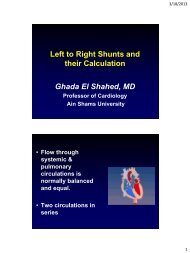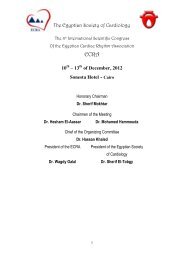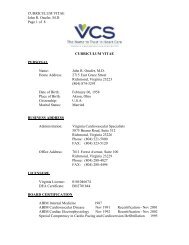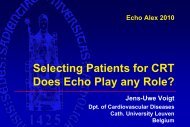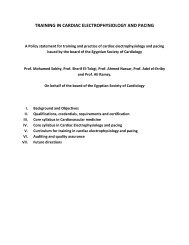the egyptian society of cardiology board of ... - Cardioegypt.com
the egyptian society of cardiology board of ... - Cardioegypt.com
the egyptian society of cardiology board of ... - Cardioegypt.com
You also want an ePaper? Increase the reach of your titles
YUMPU automatically turns print PDFs into web optimized ePapers that Google loves.
Egypt Heart J 62 (1): 7-17, March 2010<br />
Cardiac Affection after Subarachnoid Hemorrhage, Correlation with<br />
Severity and Etiology<br />
RANIA EL HOSEINY, MD; AHMED BATTAH, MD; MOHAMED ASHRAF, MD<br />
Introduction: Cardiac injury and dysfunction after subarachnoid hemorrhage (SAH) is a well-recognized phenomenon,<br />
ECG changes, arrhythmias, serum elevations <strong>of</strong> cardiac enzymes and left ventricular (LV) systolic dysfunction have been<br />
described in SAH patients. In recent years, considerable investigative interest has been directed at evaluation <strong>of</strong> frequency <strong>of</strong><br />
this cardiac injury, clinical implications, predictors and out<strong>com</strong>e, Despite <strong>the</strong> large body <strong>of</strong> evidence testifying <strong>the</strong> development<br />
<strong>of</strong> myocardial injury in SAH, <strong>the</strong> true incidence in this population remains unknown.<br />
Methodology: Thirty patients with acute subarachnoid hemorrhage were included in <strong>the</strong> study, <strong>of</strong> whome twenty patients<br />
had aneurysmal SAH (12 women, 8 men, with mean age 47.55±12.356 years) and ten patients had traumatic SAH (4 women,<br />
6 men, with mean age 42.10±14.75 years), patients with evidence <strong>of</strong> epidural, subdural or intracerebral hemorrhage, history<br />
<strong>of</strong> cardiac disease, renal impairement and systemic sepsis were excluded from <strong>the</strong> study, All patients were subjected to detailed<br />
medical history taken from <strong>the</strong> patient or a family member, daily clinical assessment <strong>of</strong> neurological status (graded according<br />
to Hess and Hunt score) and cardiac status, daily ECG, biochemical measurement <strong>of</strong> cardiac troponin I every o<strong>the</strong>r day for 7<br />
days using IMMULITE test (reference range for upper limit <strong>of</strong> normal 1ng/ml) and transthoracic echocardiographic examination<br />
on admission (day 1) <strong>of</strong> <strong>the</strong> patient and follow-up after one week (day 7) for assessment <strong>of</strong> both global and regional systolic<br />
functions <strong>of</strong> <strong>the</strong> left ventricle, it was reported as abnormal if <strong>the</strong>re was evidence <strong>of</strong> regional wall motion abnormality RWMA<br />
or EF



